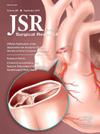The Hidden Dangers: Superabsorbent Polymer Beads as a Cause of Bowel Obstruction in Children
IF 1.7
3区 医学
Q2 SURGERY
引用次数: 0
Abstract
Introduction
Superabsorbent polymer (SAP) bead ingestion poses a challenge for children, sometimes necessitating surgical intervention due to bowel obstruction. We present a literature review and in vitro experiment to explore strategies to contract enlarged SAP beads.
Methods
A literature review (PubMed, Google Scholar) was also conducted to identify cases of SAP bead-induced bowel obstruction in children. Diagnostic strategies, treatments, and outcomes were abstracted. We then conducted an in vitro experiment where SAP beads were grown in a simulated intestinal environment (normal saline, 37°C) and exposed to potentially therapeutic agents with different osmolarities to explore size reduction mechanisms.
Results
We identified 87 patients (14.0 ± 4.5 mo) from 45 studies with bowel obstruction following SAP bead ingestion. Abdominal radiograph (73.5%) visualized the SAP bead in 5.6% of instances, whereas ultrasound (57.1%) identified the SAP bead in 85.7% of instances. 85.6% of patients required enterotomy (71.4%). Most postoperative complications were reoperations (16.3%) to remove additional beads. One mortality was recorded. In the in vitro experiment, the osmotic laxative GoLYTELY contributed to a 35.17% reduction in the size of expanded SAP beads within 24 h, demonstrating its efficacy alongside hyperosmolar solutions such as Gastrografin, prune juice, and acetylcysteine.
Conclusions
SAP beads pose significant risk in children. Hyperosmolar agents and osmotic laxatives may present a therapeutic option by reducing bead size, potentially averting the need for surgical intervention in the setting of SAP-induced bowel obstruction.
隐患:高吸水性聚合物珠是儿童肠梗阻的原因。
导读:高吸水性聚合物(SAP)头的摄入对儿童来说是一个挑战,有时由于肠梗阻需要手术干预。我们提出了文献综述和体外实验,以探索策略收缩扩大的SAP珠。方法:通过文献回顾(PubMed,谷歌Scholar)来确定SAP头部引起的儿童肠梗阻病例。总结了诊断策略、治疗方法和结果。然后,我们进行了一项体外实验,在模拟肠道环境(生理盐水,37°C)中生长SAP珠,并暴露于具有不同渗透压的潜在治疗剂中,以探索尺寸减小机制。结果:我们从45项研究中发现87例(14.0±4.5个月)患者在摄入SAP头后出现肠梗阻。腹部x线片(73.5%)在5.6%的病例中可见SAP头,而超声(57.1%)在85.7%的病例中发现SAP头。85.6%的患者需要肠切开(71.4%)。大多数术后并发症是再次手术(16.3%)去除额外的珠子。有一例死亡记录。在体外实验中,渗透性泻药golyly在24小时内使扩大的SAP珠的大小减少了35.17%,证明了它与高渗透性溶液(如Gastrografin,李子汁和乙酰半胱氨酸)的作用。结论:SAP珠对儿童有显著风险。高渗剂和渗透性泻药可能是一种治疗选择,通过减少颗粒大小,潜在地避免了对sap引起的肠梗阻进行手术干预的需要。
本文章由计算机程序翻译,如有差异,请以英文原文为准。
求助全文
约1分钟内获得全文
求助全文
来源期刊
CiteScore
3.90
自引率
4.50%
发文量
627
审稿时长
138 days
期刊介绍:
The Journal of Surgical Research: Clinical and Laboratory Investigation publishes original articles concerned with clinical and laboratory investigations relevant to surgical practice and teaching. The journal emphasizes reports of clinical investigations or fundamental research bearing directly on surgical management that will be of general interest to a broad range of surgeons and surgical researchers. The articles presented need not have been the products of surgeons or of surgical laboratories.
The Journal of Surgical Research also features review articles and special articles relating to educational, research, or social issues of interest to the academic surgical community.

 求助内容:
求助内容: 应助结果提醒方式:
应助结果提醒方式:


